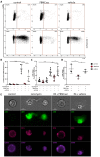The Effect of Paracrine Factors Released by Irradiated Peripheral Blood Mononuclear Cells on Neutrophil Extracellular Trap Formation
- PMID: 36009277
- PMCID: PMC9405389
- DOI: 10.3390/antiox11081559
The Effect of Paracrine Factors Released by Irradiated Peripheral Blood Mononuclear Cells on Neutrophil Extracellular Trap Formation
Abstract
Neutrophil extracellular trap (NET)-formation represents an important defence mechanism for the rapid clearance of infections. However, exaggerated NET formation has been shown to negatively affect tissue-regeneration after injury. As our previous studies revealed the strong tissue-protective and regenerative properties of the secretome of stressed peripheral blood mononuclear cells (PBMCsec), we here investigated the influence of PBMCsec on the formation of NETs. The effect of PBMCsec on NET formation was assessed ex vivo in ionomycin stimulated neutrophils derived from healthy donors using flow cytometry, image stream analysis, and quantification of released extracellular DNA. The effect of PBMCsec on molecular mechanisms involved in NET formation, including Ca-flux, protein kinase C activity, reactive oxygen species production, and protein arginine deiminase 4 activity, were analysed. Our results showed that PBMCsec significantly inhibited NET formation. Investigation of the different biological substance classes found in PBMCsec revealed only a partial reduction in NET formation, suggesting a synergistic effect. Mechanistically, PBMCsec treatment did not interfere with calcium signalling and PKC-activation, but exerted anti-oxidant activity, as evidenced by reduced levels of reactive oxygen species and upregulation of heme oxygenase 1 and hypoxia inducible-factor 1 in PBMCsec-treated neutrophils. In addition, PBMCsec strongly inhibited the activation of protein arginine deiminase 4 (PAD4), ultimately leading to the inhibition of NET formation. As therapeutics antagonizing excessive NET formation are not currently available, our study provides a promising novel treatment option for a variety of conditions resulting from exaggerated NET formation.
Keywords: PAD4; ROS; neutrophil; neutrophil extracellular traps (NETs); peripheral blood mononuclear cell secretome; secretome.
Conflict of interest statement
The Medical University of Vienna has claimed financial interest. H.J.A. holds patents related to this work (WO 2010/079086 A1; WO 2010/070105 A1).
Figures





Similar articles
-
Paracrine Factors of Stressed Peripheral Blood Mononuclear Cells Activate Proangiogenic and Anti-Proteolytic Processes in Whole Blood Cells and Protect the Endothelial Barrier.Pharmaceutics. 2022 Jul 30;14(8):1600. doi: 10.3390/pharmaceutics14081600. Pharmaceutics. 2022. PMID: 36015226 Free PMC article.
-
The secretome of irradiated peripheral blood mononuclear cells attenuates activation of mast cells and basophils.EBioMedicine. 2022 Jul;81:104093. doi: 10.1016/j.ebiom.2022.104093. Epub 2022 Jun 4. EBioMedicine. 2022. PMID: 35671621 Free PMC article.
-
The secretome of stressed peripheral blood mononuclear cells increases tissue survival in a rodent epigastric flap model.Bioeng Transl Med. 2020 Sep 22;6(1):e10186. doi: 10.1002/btm2.10186. eCollection 2021 Jan. Bioeng Transl Med. 2020. PMID: 33532586 Free PMC article.
-
Neutrophil Extracellular Traps in Periodontitis: A Web of Intrigue.J Dent Res. 2016 Jan;95(1):26-34. doi: 10.1177/0022034515609097. Epub 2015 Oct 6. J Dent Res. 2016. PMID: 26442948 Review.
-
Neutrophil Extracellular Trap Formation: Physiology, Pathology, and Pharmacology.Biomolecules. 2019 Aug 14;9(8):365. doi: 10.3390/biom9080365. Biomolecules. 2019. PMID: 31416173 Free PMC article. Review.
Cited by
-
Retrospectives on Three Decades of Safe Clinical Experience with Allogeneic Dermal Progenitor Fibroblasts: High Versatility in Topical Cytotherapeutic Care.Pharmaceutics. 2023 Jan 4;15(1):184. doi: 10.3390/pharmaceutics15010184. Pharmaceutics. 2023. PMID: 36678813 Free PMC article.
-
Elevation of neutrophil-derived factors in patients after multiple trauma.J Cell Mol Med. 2023 Jul;27(13):1859-1866. doi: 10.1111/jcmm.17786. Epub 2023 Jun 16. J Cell Mol Med. 2023. PMID: 37328954 Free PMC article.
References
Grants and funding
LinkOut - more resources
Full Text Sources
Other Literature Sources
Research Materials

